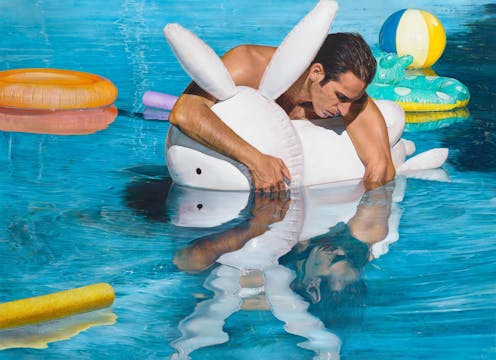the hyperrealistic (and divisive) paintings of Michael Zavros
- Written by Sasha Grishin, Adjunct Professor of Art History, Australian National University

Michael Zavros’s art is autobiographical to an obsessive – even neurotic – degree.
Not only is much of his work self-referential with images of self, his children, his aspirations and his daydreams, but the whole discourse around his art has been formulated by the artist through his endless interviews, his social media presence and the mythology he has cleverly constructed around himself.
Even the essays in the catalogue accompanying this new exhibition at the Gallery of Modern Art, Brisbane, are riddled with quotations from the artist. Do we know too much about Zavros and what he thinks he is trying to achieve in his art to be able to see his art?
How would we respond to this exhibition if we happened upon it by chance in a gallery in downtown Thessaloniki and were told it was by some contemporary Greek artist whose name we didn’t know? Would it make sense and how would we negotiate it?
Zavros is identified with an exacting photorealist technique. Much of his earlier work was derived from found imagery of desirable fashion accessories and celebrated brand names that he would render in a painstaking manner as exactly and as lovingly as he could.
This exhibition is the first comprehensive survey of Zavros’s work in a state gallery and is selected from his work from the past 25 years. Assembled by curator Peter McKay, it contains over 100 pieces, primarily paintings, but also including sculptures, photographs, video pieces and performance art.
Read more: What should the Australian War Memorial do with its heroic portraits of Ben Roberts-Smith?[1]
Mastery of technique
What are we to make of his oeuvre to date? Zavros exhibits a mastery of an exquisite technique and a refined sensibility. Nothing is left to chance. Every detail is carefully calculated.
Photography plays a key role in his art making. In his earliest pieces, clippings from a fashion magazine were meticulously reproduced as oil paintings as in Man in wool suit (1998).
Aspirational garments, fashion statements and great architectural edifices were carefully studied, appropriated and translated into a photographic form.
Depending on scale, this was sometimes carefully projected onto a painting surface. The huge Acropolis Now (2023) mural in acrylic, measuring about 7.5 metres by almost 20 metres, frames the entrance to his exhibition.
Other designs from photographs may be plotted onto a canvas through the very traditional dot method, or resolved in Photoshop and then transferred before being painted.
As a general observation, the photographic origins of most of his works – despite the attempted and frequently successful attempts at verisimilitude – is generally reflected by a certain prevailing flatness in the paintings.
This applies to some of the most accomplished and acclaimed pieces including Bad Dad (2013), and Phoebe is dead/McQueen (2010).
Conspicuous consumption
Invariably the question arises concerning the ideology or the conceptual underpinnings of Zavros’ imagery.
On a very simple level, one can say much of his imagery touches on highly desirable luxury goods, as items of conspicuous consumption. The artist has reasoned that, as many people aspire to own such items, exquisitely rendered images of them would appeal to the same people.
This, together with the knowledge Zavros belongs to a family of Cypriot Greek and Irish immigrants living on the Gold Coast where such aspirational items would be economically out of reach for them, provides a certain confidence in such a reading.
Artistic success has brought out the narcissist in the artist with such hypnotic images as V12/Narcissus (2009), where the artist has appropriated a pose from the famous Caravaggio painting Narcissus[2]. Now it is the artist reflected in the shiny surface of his brand-new car.
Is Zavros celebrating the existing world order and its elite and the consumption of luxury goods, or is he critiquing it, shining a light on folly and exposing it with irony and creating subversive art?
This seems to be a basic divide between his supporters who acquire his work at ever-increasing prices[3] and his detractors[4] who view him essentially as an artist dedicated to the Ancien Régime[5] who has a vested interest in propping up its existence.
Read more: Buy art because you love it – not because it might make you rich[6]
Power and prestige
On the evidence presented in this exhibition, there seems to be a development in his thinking from appropriation and celebration to a questioning of earlier assumptions.
It is difficult to view pieces including The poodle (2014) other than as a critique of a society completely out of control and sacrificing function for the sake of cute design.
The large installation piece Drowned Mercedes (2023) has the aspirational car of his dreams made functionless by being filled with water.
As with most of Zavros’s work, there is an autobiographic element. In the garage of the house where he normally parks his car, during the floods the water would have flooded this car. This gleaming symbol of power and prestige is destroyed through the impact of climate change.
Zavros, who is one of Australia’s most successful younger artists – he will turn 50 next year – has reached a certain watershed in his career.
Reflecting on the experience of this major exhibition, he told me he had a “scrapbook full of ideas” and will now have the opportunity to do something about it with large-scale installations and painted bronzes.
Let’s hope this comes to fruition.
Michael Zavros: The Favourite is at the Gallery of Modern Art, Brisbane, until October 2.
References
- ^ What should the Australian War Memorial do with its heroic portraits of Ben Roberts-Smith? (theconversation.com)
- ^ Narcissus (en.wikipedia.org)
- ^ ever-increasing prices (www.couriermail.com.au)
- ^ his detractors (www.smh.com.au)
- ^ Ancien Régime (en.wikipedia.org)
- ^ Buy art because you love it – not because it might make you rich (theconversation.com)

















